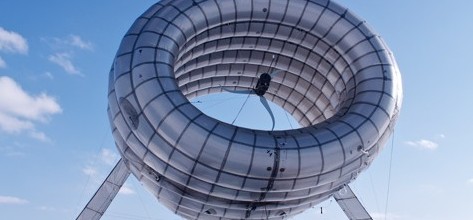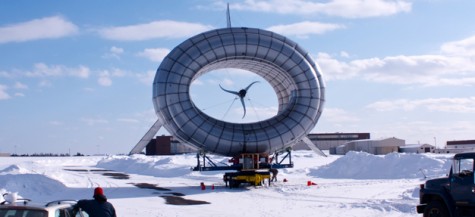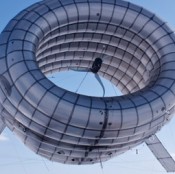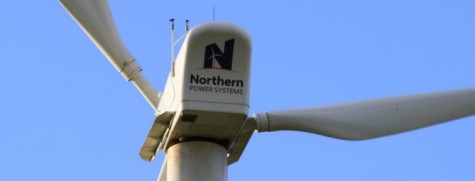After landing a cool $1.3 million from the state of Alaska to test their new airborne wind turbine, Ben Glass and Adam Rein, the young co-founders of Altaeros Energies, became the latest poster boys representing MIT's reputation for pumping out useful innovation. Four years ago, when the two graduated from MIT, it was obvious how much they'd had been shaped by the university's entrepreneurial DNA. They could have walked into GE and swapped their diplomas for jobs, but they'd already built their own rival technology. They also had a fully tweaked elevator pitch and a smart business plan (again, courtesy of MIT), that opened a lot of angel investors' doors, where they bagged vital seed money.

Plundering blimp technology
The two partners made the most of their cash-burn by quickly scaling up a prototype. In 2012, at a frigid, snowbound Air Force base in Maine (anticipating future deployments), their Buoyant Air Turbine or BAT, named after the helium-filled shell that floats high above the ground, harnessed the powerful winds at 300 feet and produced far more energy than similar turbines on the ground. Then last August, it was successfully tested again at 500 feet, in stronger 45-mph winds. And thanks to a savvy company promo that went viral on YouTube, hundreds of thousands of fans are now rooting for their turbine's success. Although the silver-sheathed turbine may look exotic, Glass and Rein know that conservative utilities can take years before green-lighting infrastructure projects, so rather than going for "a moon shot," Mr. Rein told the New York Times, "what we really tried was the safe shot." With that in mind, they ransacked the blimp industry for time-tested technology and then transformed it into an advanced, software and sensor-driven aerostat platform.

Deployed in just 24 hours
Saving time and money: call it pop-up infrastructure. Since the BAT is inflated on site, eliminating costly cranes, cement foundations and steel towers, it can be deployed in under 24 hours. A deflated BAT is also easily packed into two mid-sized shipping containers and transported anywhere in the world, where it's re-inflated and launched into the air. Once aloft, three tethers connect the BAT to a rotating ground station, from which it operates almost autonomously. As power travels down a tether to the ground station, on-board anemometers can detect wind speeds and adjust the craft's optimal altitude and direction. The BAT can also self-dock during emergencies like rough weather or a broken tether.

Heading off-grid From the beginning, Altaeros targeted a small niche far off the grid: villages, islands, mines, or disaster zones that rely on expensive diesel power. And prime real estate would be anywhere a traditional turbine can't be delivered or constructed. Altaeros' ability to reduce operating costs, particularly for Alaska, said Alan Baldivieso, program manager for emerging energy at the Alaska Energy Authority, "makes this type of deployment very attractive." The authority awarded Altaeros the grant from its Emerging Energy Technology Fund because fuel is so expensive in parts of Alaska. As Glass and Rein prepare their 30 kilowatt BAT for its 18 month commercial demonstration, where it will fly 1,000 feet above the ground, they say it will provide power to 12 homes for $0.18 per kilowatt-hour, about half the normal price of off-grid electricity in Alaska. Altaeros wants to show that their turbine is less costly than the Northern Power Systems 100, a popular, 100Kw turbine built for cold, harsh climates, which has replaced many diesel generators in Alaska. While supplying power to 25 to 30 homes, the NPS 100 "Arctic Model" is capable of operating in conditions as low as -40C. (NPS company demo video) This could be a formidable challenge for Altaeros, since their turbine is always described as "conventional."

According to the Alaska Village Electric Cooperative (AVEC), a nonprofit electric utility serving 54 communities in Western and Interior Alaska, many small towns have used three of the 100-kilowatt turbines to generate up to 20 percent of their power needs. Since Altaeros has said their BAT design will be scaled up and hopes to have a 100-kilowatt model available in a couple of years, utilities in Alaska want to test its potential. But the BAT promises extra services that could make it more useful than the NPS 100. Glass told Technology Review, it can lift additional "payloads," like weather monitoring and surveillance equipment. He thinks that the most useful addition is Wi-Fi: "If you can put a Wi-Fi unit up outside the village, you're much higher than you'd get with a traditional tower. That would allow you to cover six to eight times the area you would with a tower."
Designed during free time at MIT
Glass has been working on BAT since he was an undergrad, finally working out the basics while finishing his master's degree in aeronautics. He designed the BAT in his free time, starting from the premise that typical towers couldn't reach powerful winds blowing high above the ground. Then he brought his concept to Energy Ventures, a class at the MIT's Sloan School of Management where engineering and business students collaborate on startups for clean tech ideas. That's where he met Adam Rein, a teacher's assistant and an MBA student. Rein helped him develop the company's initial business model. Today, the company's headquarters in Greentown Labs, a clean-tech incubator cofounded by Rein, is crazy with last-minute activity. To prepare for the Alaska trial, a small group of employees are doing extra computer modeling as they enhance algorithms. Soon they'll be packing the BAT and shipping it off to withstand the harsh Alaskan winter during its most important test.
MIT's real world experience
As wrap-up activity buzzes around him, Glass sees that his undergraduate years on MIT's Solar Electrical Vehicle Team, where he built and raced solar cars, equipped him the skills to bring the BAT from concept to reality. "Just being able to see a project from the design stage through building, testing, and operating was valuable," he told Technology Review. It's obviously helped him to lead the technical team at Altaeros to refine a new energy tool that might have an impact on the real world.


